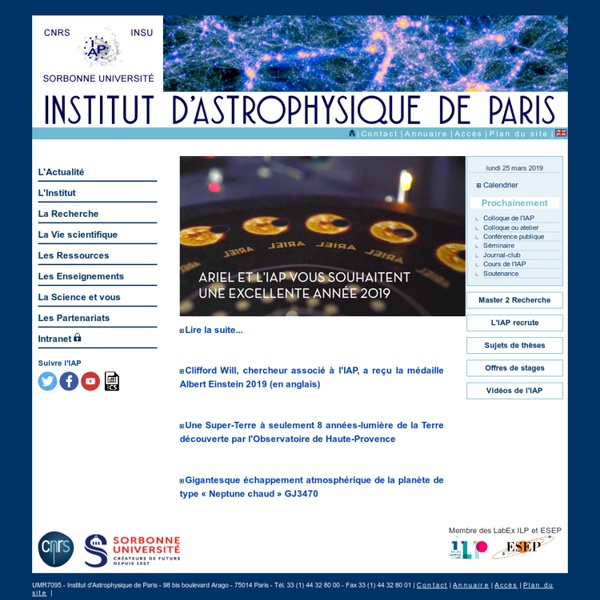



Institut d'Astrophysique de Paris - Enseignement secondaire Avant toute chose il est bon de rappeler que le métier d'astronome vient du fond des temps, dès que l'être humain a observé le ciel à l'aide du premier instrument astronomique qu'il ait eu à sa disposition, à savoir l'œil. En cela l'astronomie est historiquement une science d'observation. L'astrophysique est plus récente, elle est l'union entre la physique et l'astronomie ; l'univers est alors utilisé comme un immense laboratoire de physique ; des observations, des expériences y sont menées et interprétées à travers toutes les connaissances apportées par la physique, mais aussi par la chimie et d'autres disciplines scientifiques connexes. Les astronomes ont pour mission d'étudier les différentes composantes de l'espace cosmique, depuis les planètes proches jusqu'aux plus grandes structures de l'univers en passant par les étoiles, les galaxies, etc. Pour cela ils utilisent les méthodes de la physique, c'est pourquoi on les qualifie aujourd'hui plus volontiers d'astrophysicien(ne)s.
Département d'Astrophysique Découvrir les projets de nos laboratoires Explorer nos instruments de recherche Modéliser l'univers et ses phénomènes Archiver et gérer les connaissances Thomas.Leuthard.Photography Astrophysique Un article de Wikipédia, l'encyclopédie libre. L’astrophysique (du grec astêr = étoile, astre et physis = science de la nature, physique) est une branche interdisciplinaire de l'astronomie qui concerne principalement la physique et l'étude des propriétés des objets de l'univers (étoiles, planètes, galaxies, milieu interstellaire par exemple), comme leur luminosité, leur densité, leur température et leur composition chimique. Actuellement, les astronomes ont une formation en astrophysique et leurs observations sont généralement étudiées dans un contexte astrophysique, de sorte qu'il y ait moins de distinction entre ces deux disciplines qu'auparavant. Disciplines de l'astrophysique[modifier | modifier le code] Il existe différentes disciplines en astrophysique :
Le Soleil Le Soleil fait partie d'un système stellaire d'environ 140 milliards d'étoiles : la Voie lactée, notre Galaxie. La plupart sont concentrées dans une région en forme de disque délimitée par des bras qui se répartissent en spirale à partir d'un noyau central. Le Soleil occupe une position périphérique à 28 000 années-lumière du centre, autour duquel il tourne à une vitesse de 225 km/s. Il effectue une révolution en 250 millions années.
Maison Européenne de la Photographie Cours d’Astronomie Astronomia est astrorum lex quae cursus siderum et figuras et habitudines stellarum circa se et circa terram indagabili ratione percurrit.Isidore de Séville, ecclésiastique espagnolné entre 560 et 570 à Carthagène, mort le 4 avril 636 Je chante pour mon vallon en souhaitant quedans chaque vallon un coq en fasse autant. Chantecler, Edmond Rostand Donné au siège d’ANDROMEDE (Observatoire de Marseille) Ce cours est destiné à toute personne ayant éprouvé de la curiosité pour le ciel, pour le passé de la Terre et son avenir, ayant le désir de comprendre ce que sont les objets dont on parle souvent : planètes, satellites, étoiles, quasars, pulsars, naines blanches, géantes rouges… Mais aussi objets ou phénomènes moins connus, magnétars, sursauts gamma…
NASA Hélène Grimaud - Official Website
Outre une présentation institutionnelle de l'Institut d'astrophysique de Paris, le site présente les programmes de recherche en cours, des images d'objets célestes, une rubrique d'actualités astronomiques... by labibdevilleneuve Aug 26